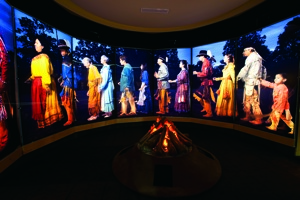
Courtesy Chickasaw Cultural Center
SULPHUR, Okla. — The Chickasaw Cultural Center, which opened July 24, uses the latest technology, live demonstrations, ancient artifacts and natural outdoor spaces to tell the Chickasaw story.
The center, located on 109 acres adjacent to the Chickasaw National Recreation Area, includes a large exhibit center, a research center, a 350-seat large-format theater, an amphitheater, a re-created traditional village, a sky terrace and several water features.
Inside the exhibit center, a replica of a 60-foot-wide, 18th-century council house serves as an orientation theater with a short film about the beginnings of the Chickasaw nation.
After the film, the projection screen rises and visitors walk beneath a rock ledge and over a stream into the 2,500-square-foot Spirit Forest, a place where technology and theatrical effects mimic the natural sights and sounds of a forest to tell the ancient Chickasaw story.
A variety of language learning stations are placed throughout the exhibit center. Touch a picture of an object, hear the Chickasaw word aloud and repeat the word into a microphone. Then hear your own voice speaking the Chickasaw word.
The 320-seat Kochcha’ Aabiniili’ (“outdoor seating”) Amphitheater hosts a variety of communal activities: lectures, plays, storytelling, crafts like bow-making and cultural ceremonies.
The amphitheater also hosts the Chickasaw Nation Dance Troupe and the Intertribal Dance Troupe, star stories at night, living-history performances and concerts from Jerod Tate, the Chickasaw Children’s Choir and gospel groups.
The Aaimpa Cafe features an extensive menu including dishes inspired by traditional Chickasaw fare, such as pashofa, grape dumplings and Indian fry bread. Seasonal items such as possum grapes, wild onions and wild greens are also included on the menu.
Traditional Chickasaw houses, including two summer houses, two winter houses, a large council house, a corn crib, a replica mound and a stockade fence are featured in the Traditional Village.
The grounds of the Chikasha Inchokka’ Traditional Village bustle with stomp dances, stickball, storytelling, spirit lessons, language and cultural demonstrations and other traditional activities.
“The key to the Traditional Village and the Culture Center is not just to see things, but to do things,” said Amanda Cobb-Greetham, administrator of the Chickasaw Nation Division of History and Culture. “The Chickasaw Cultural Center offers visitors opportunities to embrace the Chickasaw culture in many different ways.
“One important aspect of the CCC is that it is inclusive. You don’t have to be Chickasaw to benefit from a visit to the Cultural Center.”
“We want to not only preserve our history, but recognize that we have a living, thriving, growing culture to share with others,” said Bill Anoatubby, governor of the Chickasaw Nation.










